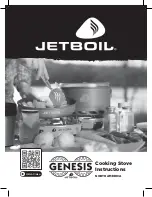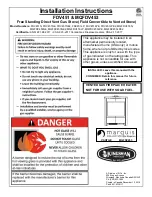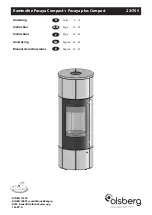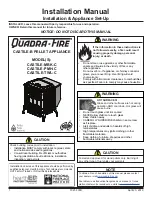
EMPTYING ASHES
Operate the de-ashing mechanism by
locating the operating tool onto the boss on the right-hand
side of the stove and moving it backwards and forwards a few
times. Use the tool to open the door and lift out the ashpan.
Remember to let ash cool before disposing in plastic sacks or
dustbins. There is no need to empty every last speck, but ash
should never be allowed to build up so that it comes into
contact with the underside of the grate.
EXTENDED BURNING
Allow the fire to burn down to a low,
hot firebed. Set the air control to 'low', empty the ash and fully
fill with hard fuel such as anthracite (smaller sizes are to be
preferred).
CLEANING
Wipe the stove body with a slightly damp cloth
when it is cool, don't use abrasives, metal polish or 'cream'
cleansers as they can scratch the surface. Polished parts can
be brightened using wire wool. Operating the stove for a few
minutes at high output will usually burn-off any window
deposits left by tarry or wet fuels. After a period of use tiny
hairline cracks may appear on the window, this is not a fault
and will not increase the risk of breakage but is a
characteristic of the toughest and most heat-resistant material
currently available.
OPENING THE DOOR
Tiger is designed to be operated only
with the door closed. Open the door slowly when refuelling or
de-ashing to minimise fume emission.
FUELS
In certain areas you are required by law to burn smokeless
fuels. Different fuels have
very
different burning
characteristics - we strongly recommend that you try a
selection of fuels (or mixtures) to find which suits you best.
WOOD
(Not smokeless) When wood is cut down its cells are
full of water. Burning such wet or 'green' wood wastes heat in
making steam and produces flammable, acidic tars which will
cling to, and can damage, your stove and chimney. Logs
should be dried for at least a year (outside under a tarpaulin
will do). When dry enough to burn, the ends will split. The
fine, white residue produced when wood burns is not ash, but
the remains of cell walls which can burn if kept hot enough,
so don't de-ash the fire until absolutely necessary.
HOUSECOAL (or BITUMINOUS COAL)
(Not smokeless) Is
raw, natural coal. Inexpensive, easy to light and low in ash, it
burns with great heat and an attractive flame. However, it
makes lots of tarry smoke which will tend to stain the window
and large volumes of flammable gas which make it difficult to
control. Do not use housecoal.
COKE
(Smokeless) Is natural coal from which the smoke has
been removed (the smoke is distilled to make aspirin,
creosote, ink and all sorts of useful things).
ANTHRACITE and WELSH DRY STEAM COAL
(Smokeless) Are natural hard, shiny forms of coal. Though
difficult to light, they burn with great heat and last a long time.
Choose the 'small nuts' size.
PEAT
(Legally smokeless in certain areas) Is natural semi-
decomposed woody material. The nearly black moorland or
bog peat should be dried and treated as for wood.
LIGNITE
(Not smokeless) Is a natural mineral, between peat
and coal. It lights easily and burns well, though some varieties
produce excessive ash
BRIQUETTES
Are compressed blocks of fuel, generally able
to burn for long periods and remarkable for their consistency.
'Homefire' and 'Phurnacite' are smokeless types while other
brands are made from lignite, peat or housecoal.
PETROLEUM COKE
is made from oil waste. Easy to light
and to control, its exceptional heat and lack of protective ash
mean that it
MUST NOT
be used unless mixed with another
fuel. Grate and firebar life will be drastically reduced when
using petroleum coke
HOUSEHOLD WASTES
Some plastics give off toxic fumes
when burned and remember that batteries and aerosols
explode! Tiger is not an incinerator, so only ever use the
recommended fuels and
NEVER
use liquid fuels in any form
PROBLEMS?
Problems like those listed here are usually due to some
difficulty with the installation, chimney or fuels, so please
check back through this leaflet carefully.
POOR HEAT OUTPUT
Tiger is sufficient to heat a typical
room of up to 100m³. The actual size depends on the
insulation and air-change ratio of the room. To attempt to heat
a larger room will result in excessive fuel consumption. Use
only the recommended fuels. If necessary seek specialist
advice.
LACK OF CONTROLLABILITY
Some fuels give off lots of
very flammable gas when they get hot. Wood may burn
excessively until the gases have been used up. You can
reduce this effect by making sure that the fire is set to 'low' for
a while before refuelling and checking that the door seals
fully.
WINDOW GETS VERY DIRTY
Extended use at low output
can cause stains on the window, which usually disappear
when the stove is used on 'high' with the airwash fully open.
Reduce the risk of stains by using only very dry fuel.
DIFFICULTY BURNING FOR EXTENDED PERIODS
If the
fire goes out with fuel still in the firebox, then this is probably
because too little air has been reaching it, try leaving the air
control open a little more. Check that the door seals are
sound and that there are no cracks or gaps anywhere in the
flue. For longest burning, we recommend hard fuels such as
anthracite.
SMOKE COMING INTO ROOM
Fumes are poisonous-
smoke emission must not be tolerated. Causes might be:
•
INADEQUATE SEALS: Check that the flue is fully sealed
to the appliance and throughout its entire length. Even the
tiniest crack or gap can spoil the draught.
•
UNSUITABLE, BLOCKED OR UN-SWEPT CHIMNEY:
The first requirement for correct operation is a sound
chimney. Check the requirements earlier in this document
and in any case of doubt have the chimney professionally
swept.
•
POOR AIR SUPPLY: Lack of air to the fire will cause
smoking and poor performance. Air supply problems may
be worse in certain wind conditions (often incorrectly
ascribed to 'downdraught', which is in fact very rare),
where air can be sucked out of the room. Fit an air vent,
as near to the fire as possible, facing into the usual wind
direction.
•
DOWNDRAUGHT: Wind can blow
down
a chimney if
there is something higher nearby such as a tree, hill or
high building. This can be cured by fitting an anti-
downdraught cowl to the chimney top.
CHIMNEY FIRES:
In the rare event of a chimney fire - usually
identified by a roaring sound and dense clouds of black
smoke and sparks exiting the top of the chimney -
immediately close the door of your 350, shut all the air
controls and call the fire brigade. Prevent fires by having your
chimney swept at least annually, or more often if smoky fuels
are used.
3






















